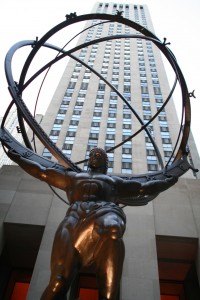“Atlas Shrugged – Part II” was released on Friday. Those of you who read this column regularly know that I’m a fan of Ayn Rand, although I place myself far short of devout Objectivism. I’ve sported “Who is John Galt?” license plate frames on my cars for years, and given dozens of copies of the book to business colleagues as gifts.
Few of those who receive the book from me actually finish it. I can understand why. It is very long, and it’s shortcomings as a novel become emphasized in film. There are no real subplots, and character development is limited. Pretty much what you see is what you get. The good guys are good and the bad guys are bad, and they all make that plain within a page or so of being introduced.
 Part II follows closely on the heels of Part I (2011) so it is a bit jarring to have all the characters and settings change. Not only have Dagney, Francisco, James and Hank aged (all played by different actors) but Wesley Mouch, while still portrayed by someone known for nasty characters (the dependably dislikable Paul McCrane) is a stereotype, but a completely different stereotype. Minor characters like Phillip Rearden, Paul Larkin and Orren Boyle have simply disappeared.
Part II follows closely on the heels of Part I (2011) so it is a bit jarring to have all the characters and settings change. Not only have Dagney, Francisco, James and Hank aged (all played by different actors) but Wesley Mouch, while still portrayed by someone known for nasty characters (the dependably dislikable Paul McCrane) is a stereotype, but a completely different stereotype. Minor characters like Phillip Rearden, Paul Larkin and Orren Boyle have simply disappeared.
The impact of the world situation remains the same, however. Protestors picket corporate headquarters, carrying signs proclaiming them to be part of the 99.8%. Gasoline is scarce, and a full tank costs $800. New laws flood out of Washington, progressing from the normal-sounding (The Equalization of Opportunity Act) to the fanciful (The Anti Dog Eat Dog Act) to the terrifying (The all-powerful “Directive 10-289”).
Coming this close to the presidential election, Ms. Rand’s 55 year old story rings with the themes of conservatives today. Business is good. Those who create jobs are the engines of society. Their ethical quest for profits is a noble motive, and wealth is just the way that the benefits of their creation are spread through the rest of the population.
Any business owner has to feel a chill when the Director of Economic Planning proclaims the “New Capitalism,” where all business must work under the guidance of government to benefit society as a whole.
It is easy to draw parallels to the regulatory approach of the Obama administration, but Rand would see our current government as a logical extension of all that came before. Research on Presidential “Czars” for example, leads to some interesting findings.
Franklin Roosevelt was the first to appoint people with direct authority for government action without getting prior approval from the Senate. He did it 17 times. Following FDR’s Presidency, the number of such unvetted appointees ranged from 9 (Truman) to zero (Eisenhower and George H.W. Bush). The practice really accelerated under George W. Bush, who named 28 Directors, more than triple the number of any President since FDR, without legislative approval. Barack Obama is only slightly more fond of imperial appointments, with 33.
The problem isn’t that government continues to intrude on the business process, it is that business people only protest when that intrusion interferes with doing business. If the Imperial Presidency expands during strong economic cycles, or is done in a way that they find appealing, it is generally ignored. Only when that power is turned against free markets do they speak up against it.
The message in Atlas Shrugged wasn’t just against a conservative or liberal social policy. It was against the sacrifice of individual freedom to expanding executive authority. Business owners need the foresight to oppose such expansion even when an administration seems to favor them, or else face the inevitable consequences when one doesn’t.

One Response to Atlas Shrugged and the Imperial Presidency